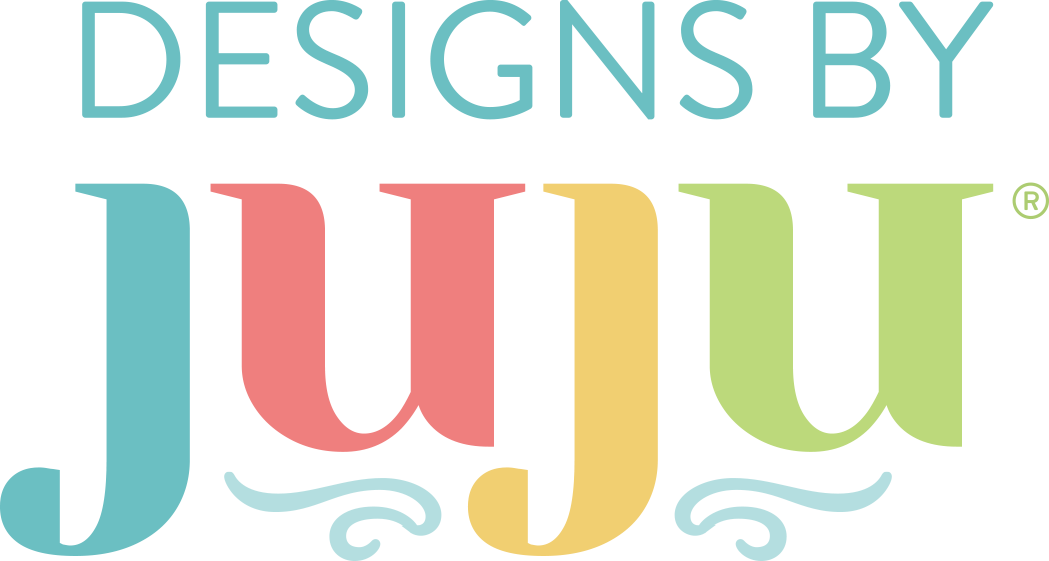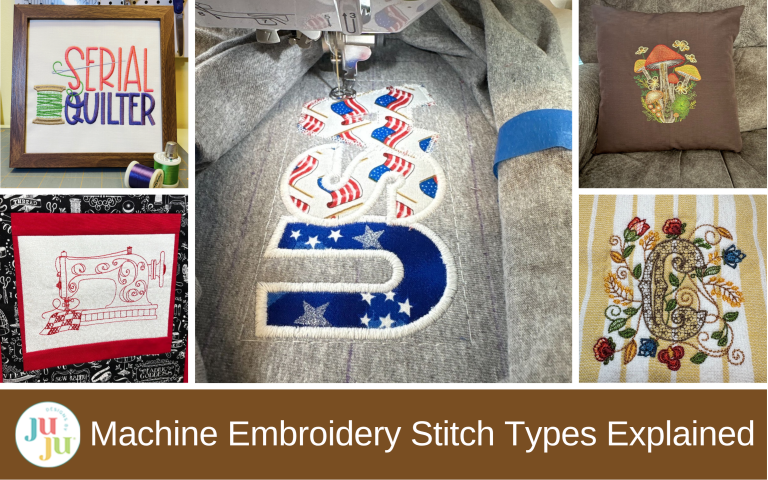Types of Machine Embroidery Stitches Explained: A Beginner’s Guide to Stitch Styles, Texture & Technique
You’ve loaded your embroidery design on your machine, your fabric is hooped, and you’re ready to begin.
If you have a machine like mine with the big green button, it’s GO time! You push the button and your machine starts stitching away. But what is it stitching? No, I don’t mean the design; I mean, what are all these different stitches the machine is doing?
Some fifty-odd years ago my mother taught me how to hand embroider. Below is a pillowcase I embroidered with her help. I didn’t know it until doing research for this blog, but embroidery machines had already been invented over 145 years earlier at the time my mother was teaching me how to do French knots. Joshua (or Josué) Heilmann is credited with fabricating the first embroidery machine around the early to mid 1800s. I’m not citing sources as I found varying years and spellings for Heilmann, but here is a fun video about early embroidery machines. By the way, I think that set of pillowcases was the only hand embroidery I ever did.
Today all my embroidery is done by machine, but a lot of the stitches are really the same. The Product Details included with DBJJ’s designs usually tell you what types of stitches the machine will use, but maybe you aren’t familiar with all the terms.
Here are the Product Details for one of DBJJ’s beautiful new designs, the Floral Sewing Machines 1 Embroidery Set.
“These designs feature a gorgeous mix of embroidery stitch types, including decorative motif, sketch, satin, and bean, as well as multiple color layers of lighter density fill to create a blended, variegated, textured look.”
As you can see, there are several types of stitches used in machine embroidery. Let’s take a look at them.
Supplies
Because this article is not a tutorial, I am not listing out any supplies, but here’s a friendly reminder to check out the DBJJ team’s favorite supplies in the Designs by JuJu Amazon store for all your embroidery needs.
DBJJ designs used or referenced in this project:
- Floral Sewing Machines 1 Embroidery Set
- Sewing Room Word Art 1
- Cordelia Monogram
- Vintage Botanicals
- Elegant Mushrooms Sketch
- Stay Positive Word Art
- USA Applique
- Daisy Doodle Bean Stitch Applique Alphabet
- Tropical Alphabet Embellishment Kit
- Bon Appetit Redwork
- Vintage Sewing Machines Redwork
Decorative Motif
A decorative motif stitch is a repeating pattern. It’s used for making lines and for filling in spaces. It can be a simple pattern or one that really stands out and makes the design more textured.
Here a motif stitch was used on the spool of thread in this design from Sewing Room Word Art 1 that gives the thread texture.
In the Cordelia Monogram pictured below, the motif stitch is a gorgeous little flower pattern. Here the motif purpose wasn’t to provide texture but to be a standout feature of the whole design. I stitched this on a Better Homes and Gardens towel purchased at Walmart.
Sketch Stitch
Sketch stitches are light and airy stitches. Think about the idea of sketching a picture in a notebook. You draw simple lines, maybe do a little shading, using a light touch with the pencil. Shading with sketch stitches is achieved by increasing (or decreasing) the density of the stitches—the amount of lines of sketch stitch that are used within an area.
Some designs with sketch stitches don’t have completely filled elements, so you need to think carefully about your thread colors. Sometimes I still have trouble getting contrasts right, and the stakes can be a bit higher with sketch designs. If the design is lightly sketched in, the fabric you’re using will show through. However, don’t let that stop you from having fun and trying new things. Take a look at my Elegant Mushrooms Sketch pillow.
I really wanted to do this on a brown fabric. It meant that I needed to think a little more when selecting my threads because the brown wasn’t going to be completely covered. I looked at the color chart for the suggested colors, but especially for under the mushroom caps and stems, when the suggested colors were dark, I used lighter threads.
It was so much fun to watch this stitch out, it was as though the sewing machine were painting the lines! In the close-up you can see the simplicity of the sketch stitches. I used a variegated thread for part of the main stem, which I love. It gives just a touch more depth to the stem color. At the time, I wished I had other variegated threads, but if I had had more, I would have needed to make sure that all the colors that would appear would contrast with my brown fabric and not disappear into the brown.
DBJJ strongly recommends not resizing sketch stitch designs. Keep this in mind when you are choosing a design for a particular purpose or piece of clothing.
My husband really loved this pillow, asking me who it was for. I could happily tell him it’s for us!
Satin Stitch
The satin stitch is very easy to describe: it’s a zigzag stitch with a short stitch length. The width of the zigzag can vary throughout the design as needed. Below you see the shirt with the Stay Positive Word Art all done in a satin stitch. The M has a narrow width for the left stem, a wide zigzag width for the middle stem, and a slightly less wide zigzag for the right stem. The large green leaf on the left has the widest zigzag of all. The satin stitch will be used for outlining, filling in, words, and more.
If you use DBJJ’s applique designs, the heavy stitching all around the edges of the applique pieces is satin stitch.
(The thread is from Allstitch.)
Bean Stitch
Remember how I asked you to think of sketching in a notebook when I was telling you about sketch stitches? The bean stitch makes me think of drawing too, but this time I think of the heavier outlines I did with my crayons. Often as kids we even picked up the black crayon to really emphasize the outline. Compared to the straight line of sketch stitches, the bean stitch is a tripled (or more) stitch so that it really stands out.
Bean stitches are a lot of fun because they take up much less time stitching out than satin stitches. If you’ve used DBJJ’s Daisy Doodle Bean Stitch Applique Alphabet and any of the embellishment kits, you’re very familiar with bean stitches. But if you haven’t, you’ve still probably used bean stitches in some of your designs without even realizing that’s what they were called. If you look back at the mushroom caps in the close-up of the sketch stitches, you can see they are outlined with thicker lines made up of bean stitches. The next time you’re stitching out a design, if you notice a line stitching out over top of itself three or more times, chances are it’s the bean stitch.
You can see the bean stitching in the close-up below. Each stitch is worked three times as the line is stitched out.
Redwork
We began this blog article in the 1800s when the first embroidery machine was invented, and now we’re circling back to the same time period for the last stitch we’re going to talk about today.
Redwork became popular in the 19th century because of a thread that became available at the time. It was inexpensive, colorfast, and . . . red. In fact, it was called Turkey Red. The designs were simple—kind of like line drawings—so designs were easily embroidered in household after household.
Today, DBJJ has lots of redwork designs to choose from. A few years ago I scored points with a red-loving daughter-in-law when I made her kitchen towels with these red chefs.
Because redwork designs are mostly linework, or outlines, they are very quick to stitch out.
This little wall hanging took me no time at all to stitch out, put borders on, and hang on my mini-stand.
Even though these designs are called redwork, you can stitch them out in any colors you’d like. One of the advantages of belonging to the Designs by JuJu Embroidery Blessings Facebook Group is that you can search the projects people post. When I did a search for redwork designs, I found many people used different colors, including member Janine Colasurdo, who stitched an absolutely gorgeous sewing machine in gold on a black fabric for her sewing machine cover, and member Kerry Davis, who stitched redwork blocks out in black for a quilt. Not a member yet? Here's another great reason to join today!
Happy stitching with all these different types of machine embroidery stitches and DBJJ’s lovely designs!
Please share your projects in the Designs by JuJu Embroidery Blessings Facebook Group, or anywhere on social media using the hashtag #designsbyjuju. We’d love to see what you create!


